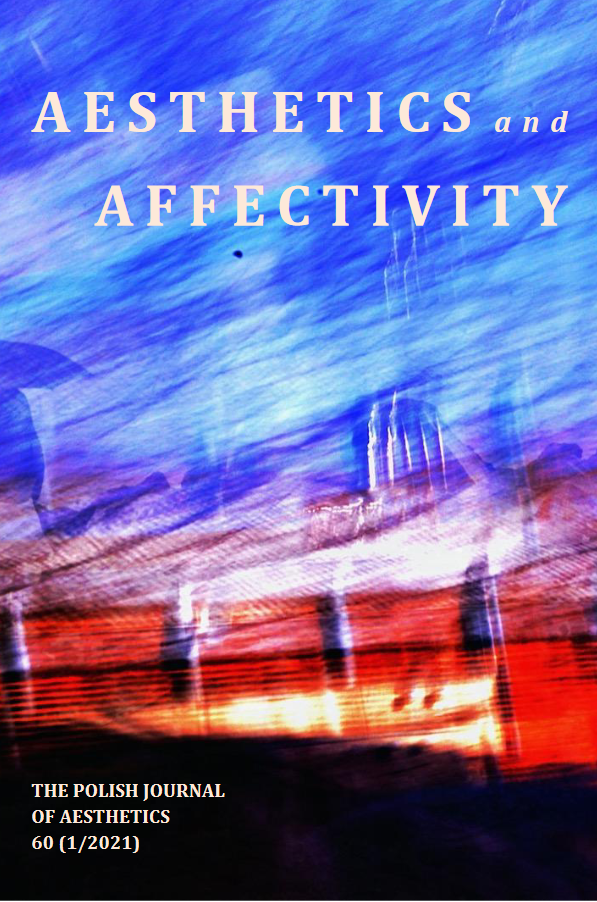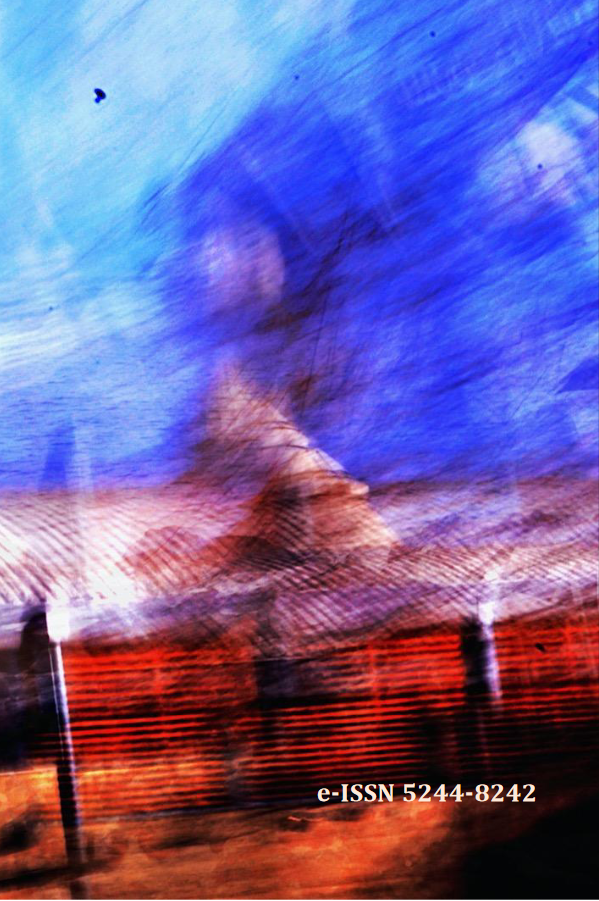Numer 60 (1/2021)
Aesthetics and Affectivity|
Spis treści
Strony
Pobierz
|
|||||
|
|
|||||
|
Streszczenie The role of affectivity in aesthetic experience, and its importance in the study of aesthetics, is highlighted in this special issue. As the editors indicate in their introduction, it has been a theme since ancient times. And yet there remains some ambiguity about this since affectivity is so closely associated with the body, and, at least on many conceptions, aesthetics is supposed to involve experiences on a higher plane. Recent science and philosophy have focused on more cognitive contributions to our understanding of mind and experience, and in some cases this focus leads theorists to ignore affectivity. I think this is sometimes reinforced by a particular framing of issues in the field of aesthetics when it is oriented to the experience of the observer or appreciator of the artwork. One way to redirect our considerations is to think of the aesthetic experience of the artist, and specifically the performer, in the context of performing arts. INFORMACJE O AUTORZE
University of Memphis, USA
University of Wollongong, Australia |
|||||
|
|
|||||
|
Streszczenie Feelings, emotions, phenomena of empathy and sympathy, appetites, desires, moods, and generally the whole sphere of affectivity make up one of the most fundamental dimensions of human life which, also with the advent of the so-called “Affective Turn” in various fields of the human and social sciences, has been the object of recent rediscovery and revaluation. Sometimes this renewed appreciation of the affective and emotional dimension of experience in contemporary thought has also been put in contrast with a certain primacy of the purely representational and cognitive dimension that has been quite characteristic of modern thinking and culture... INFORMACJE O AUTORACH Laura La Bella independent researcher Stefano Marino Università di Bologna, Włochy Vittoria Sisca independent researcher |
|||||
|
|
|||||
|
Słowa kluczowe Affects |Non-cognitive Emotions |Literary Devices |fiction |PsychoStreszczenie This paper investigates the emotional import of literary devices deployed in fiction. Reflecting on the often-favored approach in the analytic tradition that locates fictional characters, events, and narratives as sources of readers’ emotions, I attempt to broaden the scope of analysis by accounting for how literary devices trigger non-cognitive emotions. I argue that giving more expansive consideration to literary devices by which authors present content facilitates a better understanding of how fiction engages emotion. In doing so, I also explore the somatic dimension of reading fiction. INFORMACJE O AUTORZE
Hong Kong Baptist University, Chiny
|
|||||
|
|
|||||
|
Słowa kluczowe Aesthetics |Duchamp |Readymades |objectivity |Ayn RandStreszczenie This article proposes a ‘reconfiguration of aesthetics’ through an interpretation of Duchamp’s readymades. The reconfigured aesthetics results in the emergence of the ready-mades as the common objects that they are; it is an aesthetics driven by objectivity and which encounters facts, rather than things. Facts are non-neutral and value-laden arrangements of things. Hence, the article proposes what it calls ‘the aesthetics of facts’. INFORMACJE O AUTORZE
American University of Malta
|
|||||
|
Marcello Sessa
The Modernist Iconography of Sleep. Leo Steinberg, Picasso and The Representation of States of Consciousness
DOI: 10.19205/60.21.3
53 – 73
|
|||||
|
Słowa kluczowe phenomenology |Pablo Picasso |Leo Steinberg |Cubism |modernismStreszczenie In the present study, I will consider Leo Steinberg’s interpretation of Picasso’s work in its theoretical framework, and I will focus on a particular topic: Steinberg’s account of “Picasso’s Sleepwatchers.” I will suggest that the Steinbergian argument on Picasso’s depictorial modalities of sleep and the state of being awake advances the hypothesis of a new way of representing affectivity in images, by subsuming emotions into a “peinture conceptuelle.” This operation corresponds to a shift from modernism to further characterizing the postmodernist image as a “flatbed picture plane.” For such a passage, I will also provide an overall view of Cubism’s main phenomenological lectures. INFORMACJE O AUTORZE
Università degli Studi di Firenze, Włochy
Università di Pisa, Włochy |
|||||
|
Amy Keating
Sticky Aesthetics, Sticky Affect: Connecting through Queer Art
DOI: 10.19205/60.21.4
75 – 91
|
|||||
|
Słowa kluczowe embodiment |Queer Aesthetics Forms |affect |Queer Temporalities |AutotheoryStreszczenie This paper explores how the creative nonfiction writer, T Fleischmann, exemplifies a “queer sense of belonging” throughout the author’s description of encountering a work of art and how it transmits this feeling to the reader. This sense of belonging is an affective feeling co-created through the intertwining elements of queer aesthetics and the encountering subject’s contingent affective history. INFORMACJE O AUTORZE
Western University, Kanada
|
|||||
|
Jandra Boettger
Guilty Wonder. An Exploration of the Aesthetic, Affective, and Political Implications of the Wondering Gaze
DOI: 10.19205/60.21.5
93 – 109
|
|||||
|
Słowa kluczowe Curatorial Studies |Fascist Continuities |Privilege |Saidyia Hartman |Walter BenjaminStreszczenie Wonder’s affective neutrality and perceptive firstness have led to its connotation with innocence and naïveté. This paper challenges the perception that wonder is a value-free stimulus. Instead, it explores wonder’s potential to unveil, expose and denude—thus playing on the difference between norm and exception. Wonder’s history is loaded with othering’s cruelty, the spectacularization of difference, and the libidinous entanglement of voyeurism, leading to the question, to what extent wonder is comprised of guilt? Subsequently, this paper supplements the notion of guilt with a differentiated account of indebtedness, following the hypothesis that wonder can also be conceptualized as a politically mobilizing affect if taken seriously. INFORMACJE O AUTORZE
Humboldt-Universität zu Berlin, Niemcy
|
|||||
|
Patrick Martin
The Shock of the New: The Experience of Groundlessness in Vattimo’s Aesthetics
DOI: 10.19205/60.21.6
111 – 124
|
|||||
|
Słowa kluczowe Gianni Vattimo |Aesthetics |Novelty |Affectivity |GroundlessnessStreszczenie The purpose of this article is to examine the themes present in Gianni Vattimo’s Art’s Claim to Truth. I argue that there is a central phenomenon that links his aesthetics to his hermeneutics: the experience of groundlessness. I consider how three aspects color this experience: the artwork’s lack of foundations, the ungrounding of our world, and an element of a-rationality/irrationality indicated by the event of art as experience—i.e., as expressed in affectivity. INFORMACJE O AUTORZE
Helsingin yliopisto (Helsingfors universitet), Finlandia
|
|||||
|
Carsten Friberg
The Education of Senses. At the Intersection between Affectivity and Aesthetics
DOI: 10.19205/60.21.7
125 – 139
|
|||||
|
Słowa kluczowe Aesthetics |Taste |Affectivity |education |perceptionStreszczenie This article makes the argument and emphasizes that aesthetic education is central for a discussion and critical awareness of affectivity with our self-perception and world-relation. Our affective relations are a component in our interaction with others with whom we share feelings and emotions, formed and learned through this interaction. Judgments of taste in which social norms are made explicit demonstrate such an education and emphasize the centrality of aesthetic education for a critical awareness of our self-perception and world-relation. |
|||||
|
|
|||||


